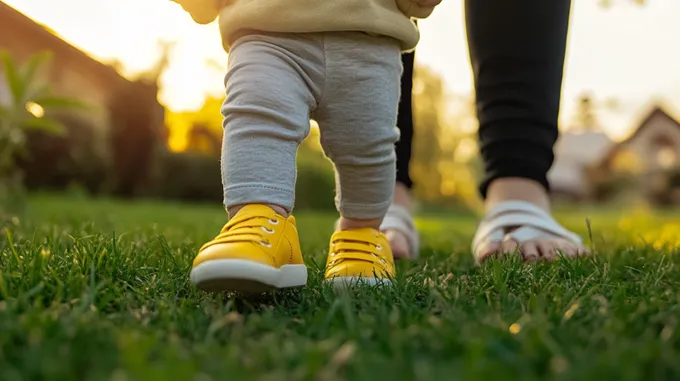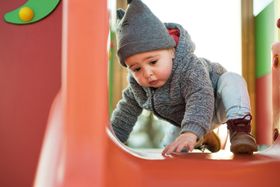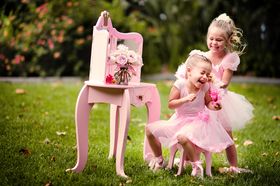How to Determine if Your Child Is Walking Correctly
A guide for parents to identify potential walking issues in their children and take proactive steps to ensure their healthy development.
Updated March 27, 2025

As parents, it’s natural to wonder whether your child’s walking development is on track. Some babies take their first steps at 9 months, while others start closer to 18 months.
But what if your 18-month-old isn’t walking yet? Or your 2-year-old gait still seems unsteady? Understanding what’s normal—and when to seek help—can give you peace of mind and ensure your child is developing healthily.
» Want to prevent walking problems for your child? Try orthopaedic shoes
When Can a Baby Walk Properly?
There is no single answer to this question. It's normal for babies to start walking between 9 and 18 months, though some may take longer. By 15 months, about 90% of babies will walk unassisted.
Here are some factors that can influence the timing:
Culture: Some cultures carry babies more often, which might delay walking.
Muscle Strength: Stronger leg muscles can help a baby walk sooner.
Practice: The more babies practice walking, the faster they might learn.
Baby's Size: Larger or heavier babies may take longer to walk, as they need extra strength to support their weight.
Family History: A genetic tendency toward early or late walking may influence a baby's development.
» Improve your walking technique by taking short steps with your kid
Key Milestones in a Child’s Walking Development
- Pushing Up: 2-5 months
- Rolling Over: 3-6 months
- Sitting With Support: 4-7 months
- Sitting Without Support: 6-9 months (some babies may start walking in this period, though this is rare)
- Scooting: 7-10 months
- Pulling Up to Stand: 8-12 months
- Crawling: 8-12 months (some skip this phase)
- Walking With a Very Wide Stance: 9-14 months
- Walking With Support: 10-14 months
- Walking Alone: 11-15 months
Note: If your baby is not walking by 18 months, it's worth seeking a professional evaluation. A delay does not always mean a problem, but early intervention can help address any underlying issues.
» Learn how to help your little one walk alone
Walking Concerns by Age: What’s Normal and What’s Not?
Every child learns at their own pace, but some walking patterns may indicate a need for evaluation.
At 18 months: Some toddlers are just late walkers, but if your 18-month-old isn’t walking at all or avoids standing, it’s worth discussing with a doctor.
At 2 years: Occasional trips and falls are common, but if your 2-year-old stumbles often or struggles to maintain balance, they may need extra support for coordination.
At 3 years: By age 3, children should walk with a steady gait. If your 3-year-old’s walking still looks clumsy or frequently falls, it might indicate muscle weakness or another underlying issue.
Did You Know?
Many articles online say that girls tend to walk slightly earlier than boys. This isn't true. The difference is minor and varies by individual development [1].
» Learn how to choose shoes for each stage of your kid's foot development
When to Worry About Your Child's Walking
Here are some of the most common concerns when kids just start walking:
- Late walking: Most children walk by 18 months, but some may take longer. It's not necessarily a problem if they are progressing steadily in other areas.
- Toe Walking: Many children walk on their tiptoes when they are first learning. It's usually harmless and goes away on its own, but you should visit a podiatrist if it persists after they are two years old.
- Awkward Gait: Some kids start out walking with a clumsy and uneven gait. Their muscles are still developing at this age, so this may not be enough to worry about.
- In- Or Out-Toeing: Most children's feet turn inward or outward when they start walking. It only becomes a walking problem when it is excessive and could be a sign of a foot abnormality.
- Bowlegs: A condition where the legs curve outward at the knees, creating a bowed appearance when standing. If the bowlegs are severe or persist beyond the expected age range—usually around 2-3 years old—it may be a sign of an underlying issue.
- Flat feet: It's common for young children to have flat feet or a very low arch. Their feet are still developing, and the arch will likely form over time. As children grow, their feet typically develop more structure.
- Knock-knees: When the legs curve inward at the knees, creating a knocked appearance when standing. The Knees may also touch when the feet are kept apart.
- Metatarsus Adductus: A foot deformity where the forefoot is pointed inwards, with the toes and metatarsals (foot bones) angled towards the midline.
Did You Know?
Some studies suggest a possible link between early motor development and later ADHD diagnoses, though this is not definitive [2]. If your baby walks early (before 9 months) and also shows signs of hyperactivity, it may be worth discussing with a pediatrician.
» Discover how to prevent foot injuries in your kid
What Are the Four Keys to Proper Walking Form?
For proper walking form, your little one needs to show the following:
Balanced Posture: Keeping their head and torso upright without excessive leaning.
Even Stride: Equal step length on both sides.
Proper Foot Placement: Feet should point forward, not excessively in or out.
Coordinated Arm Movement: Arms should swing naturally to maintain balance.
» Understand why your kid might waddle when walking
Conditions That Can Affect the Ability to Walk
Several conditions can impact a child's ability to walk correctly:
Neurological Conditions (e.g., cerebral palsy, muscular dystrophy)
Developmental Delays
Foot and Leg Abnormalities (e.g., clubfoot, metatarsus adductus)
Hip Dysplasia
Genetic Conditions (e.g., Down syndrome)
Nutritional Deficiencies (e.g., vitamin D deficiency causing rickets)
Watch Out for These Red Flags
If your child suddenly starts to experience any of the following, it might be a sign of something more serious:
- Sudden or ongoing pain
- Feet turning in or out too much
- Limping
- Losing skills they had before
- Fever, weakness, or muscle problems
Don't wait to see a doctor. If you notice any of these symptoms, it's important to get professional help right away.
» Check out the best exercises for flat feet
Tips to Identify Walking Problems in Your Child
- Look for progress in other areas, such as crawling, sitting, climbing, and communication. Seek a professional evaluation if your child is delayed in multiple places.
- Check if you have a family history of developmental delays or foot problems, which may suggest a similar predisposition for the child.
- Compare your child's development to their age group, not just other children.
» Recognise the first signs of foot drop in children
Treatment for Irregular Walk Patterns in Kids
The following treatment options will solve the earlier listed walking problems in children if they are identified early and action is taken immediately:
Stretching and strengthening exercises for the foot and ankle
Specialised shoes
Physical therapy
Bracing to guide bone growth
Taping or splinting to aid foot alignment
Surgery in extreme cases where deformity has set in before intervention
» Explore the symptoms of flat feet in children
Why Your Kid Might Need Specialised Foot Support
Orthopedic shoes—like the ones from First Walkers—can provide essential support for growing feet. Designed by experts, they help address common issues such as flat feet, in-toeing, and out-toeing while promoting healthy development.
They come with:
- Wide Toe Boxes to accommodate your child's developing feet.
- Breathable Materials to keep feet cool and comfortable.
- Flexible and Durable Construction to withstand the rigours of play.
- Arch Support to promote healthy foot development.
Orthopaedic shoes reduce the risk of serious walking problems later on in life by supporting proper foot development. Your child will be less likely to have bunions, hammertoes, or plantar fasciitis.
Is Your Child Walking Correctly? Spot the Signs and Take Action
Pay close attention to how your child walks. If you notice their feet turning in or out excessively, they’re limping, complaining of pain, or walking unusually, it could be a sign of a problem.
Don’t hesitate to consult with a pediatrician or specialist for a proper evaluation. Early intervention can make a big difference in addressing walking issues and ensuring your child’s overall well-being.
» Prevent walking problems in babies with orthopaedic shoes
References:
- T. Aoyama, S. Tanaka, M. Tanaka, M. Okuda, S. Inoue, and C. Tanaka, “Association between age at onset of independent walking and objectively measured sedentary behavior is mediated by moderate-to-vigorous physical activity in primary school children,” PLoS ONE, vol. 13, no. 9, p. e0204030, Sep. 2018, doi: 10.1371/journal.pone.0204030. Available: https://pubmed.ncbi.nlm.nih.gov/30226888/
- Z. Cui, S. Li, A. Liang, H. Huang, and X. Ni, “Association between reported ADHD symptom and motor development delay in preschool children,” Frontiers in Pediatrics, vol. 12, Nov. 2024, doi: 10.3389/fped.2024.1480488. Available: https://doi.org/10.3389/fped.2024.1480488
Disclaimer: First Walkers' information is intended for educational and informational purposes related to toddler footwear and feet. We encourage you to consider individual circumstances and consult qualified orthopedists about specific conditions.




